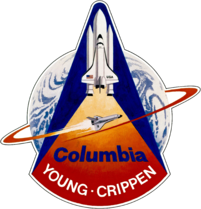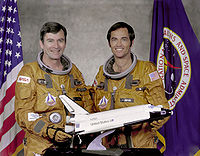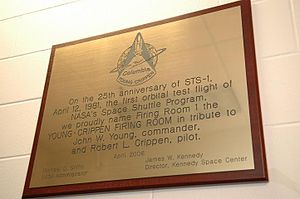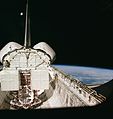- STS-1
-
STS-1 Mission insignia

Mission statistics Mission name STS-1 Space shuttle Columbia Crew size 2 Launch pad Kennedy Space Center, Florida
LC 39ALaunch date 12 April 1981 12:00:03 UTC Landing site Edwards AFB, Runway 23 Landing 14 April 1981 18:20:57 UTC Mission duration 2 days, 6 hours, 20 minutes, 53 seconds Number of orbits 37 Apogee 156 mi (251 km) Perigee 149 mi (240 km) Orbital period 89.4 min Orbital altitude 307 km (191 mi) Orbital inclination 40.4 degrees Distance traveled 1,728,000 kilometres (1,074,000 mi) Crew photo 
Crew members John W. Young (left) and Robert L. Crippen pose in ejection escape suits (EES) with a small model of the Space Shuttle orbiter. Related missions Previous mission Subsequent mission Approach and Landing Tests
 STS-2
STS-2STS-1 was the first orbital flight of NASA's Space Shuttle program. Space Shuttle Columbia launched on 12 April 1981, and returned to Earth on 14 April, having orbited the Earth 37 times during the 54.5-hour mission. It was the first American manned space flight since the Apollo-Soyuz Test Project on 15 July 1975. STS-1 was the only US manned maiden test flight of a new spacecraft system, although it was the culmination of atmospheric testing of the Space Shuttle orbiter.
Contents
Crew
Position Astronaut Commander John W. Young
Fifth spaceflightPilot Robert L. Crippen
First spaceflightBackup crew
Position Astronaut Commander Joe H. Engle Pilot Richard H. Truly Mission parameters
- Mass:
- Orbiter Liftoff: 219,256 lb (99,453 kg)
- Orbiter Landing: 195,466 lb (88,662 kg)
- DFI payload: 10,822 lb (4,909 kg)
- Perigee: 149 mi (240 km)
- Apogee: 156 mi (251 km)
- Inclination: 40.3°
- Period: 89.4 min
Mission summary
The first launch of the Space Shuttle occurred on 12 April 1981, exactly 20 years after the first manned space flight, when the orbiter Columbia, with two crew members, astronauts John W. Young, commander, and Robert L. Crippen, pilot, lifted off from Pad A, Launch Complex 39, at the Kennedy Space Center. This was the first of 24 launches from Pad A. The launch took place at precisely 7 a.m. EST. A launch attempt two days earlier was scrubbed because of a timing problem in one of Columbia’s general-purpose computers.
Not only was this the first launch of the Space Shuttle, but it marked the first time that solid-fuel rockets were used for a NASA manned launch (although all of the Mercury and Apollo astronauts had relied on a solid-fuel motor in their escape towers.) STS-1 was also the first U.S. manned space vehicle launched without an unmanned powered test flight. The STS-1 orbiter, Columbia, also holds the record for the amount of time spent in the Orbiter Processing Facility (OPF) before launch – 610 days, the time needed for the replacement of many of its heat shield tiles.
The primary mission objectives of the maiden flight were to perform a general check out of the Space Shuttle system, accomplish a safe ascent into orbit and to return to Earth for a safe landing. The only payload carried on the mission was a Development Flight Instrumentation (DFI) package, which contained sensors and measuring devices to record the orbiter's performance and the stresses that occurred during launch, ascent, orbital flight, descent and landing. All of these objectives were met successfully, and the orbiter's spaceworthiness was verified.
During flight day 2, the astronauts received a phone call from Vice President George H. W. Bush. President Ronald Reagan originally intended to visit the Mission Control Center during the mission, but at the time was still recovering from an assassination attempt which had taken place two weeks before the launch.
Columbia reached an orbital altitude of 166 nautical miles (307 km). The 37-orbit, 1,074,567-mile (1,729,348 km)-long flight lasted 2 days, 6 hours, 20 minutes and 53 seconds. Landing occurred on Runway 23 at Edwards Air Force Base, California, at 10:21 am PST, 14 April 1981.[1] Columbia was returned to Kennedy Space Center from California on 28 April atop the Shuttle Carrier Aircraft.
Mission anomalies
STS-1 was the first test flight of what was at the time the most complex spacecraft ever built. There were numerous problems – 'anomalies' in NASA parlance – on the flight, as many systems could not be adequately tested on the ground or independently. Some of the most significant are listed below:
- A tile next to the right-hand External Tank (ET) door on the underside of the shuttle was incorrectly installed, leading to excessive re-entry heating and the melting of part of the ET door latch.[citation needed]
- The astronauts' on-orbit visual inspection showed significant damage to the thermal protection tiles on the OMS/RCS pods at the orbiter's aft end, and John Young reported that two tiles on the nose looked like someone had taken 'big bites out of them'.[2] Post-flight inspection of Columbia's heat shield revealed that an overpressure wave from the Solid Rocket Booster (SRB)'s ignition had resulted in the loss of 16 tiles and damage to 148 others.[citation needed]
- The same overpressure wave pushed the body flap below the main engines at the rear of the shuttle well past the point where damage to the hydraulic system would be expected, which would have made a safe re-entry impossible. The crew were unaware of this until after the flight, and John Young reportedly said that if they had been aware of the potential damage at the time, they would have flown the shuttle up to a safe altitude and ejected, causing Columbia to have been lost on the first flight.[3]
- Bob Crippen reported that, throughout the first stage of the launch up to SRB separation, he saw 'white stuff' coming off the External Tank and splattering the windows, which was probably the white paint covering the ET's thermal foam.[2]
- The orbiter's toilet suffered from 'low urinal flow and a feces separation problem'.[4]
- Columbia's aerodynamics at high Mach numbers were found to differ significantly in some respects from those estimated in pre-flight testing. A misprediction of the location of the center of pressure (due to using an ideal gas model instead of a real gas model) caused the computer to extend the body flap by sixteen degrees rather than the expected eight or nine, and side-slip during the first bank reversal maneuver was twice as high as predicted.[5]
- During remarks at a 2003 gathering, John Young stated that a protruding tile gap filler ducted hot gas into the right main landing gear well, which caused significant damage, including the buckling of the landing gear.[6] Buckling of the door, but not the landing gear, was documented in the post-flight anomaly report.[7]
Despite these problems, STS-1 was a successful test, and in most respects Columbia came through with flying colors. After some modifications to the shuttle and to the launch and re-entry procedures, Columbia would fly the next four Shuttle missions.
Mission insignia
The artwork for the official mission insignia was designed by artist Robert McCall. It is a symbolic representation of the shuttle. The image does not depict the black wing roots present on the actual shuttle.
Anniversary
The ultimate launch date of STS-1 fell on the 20th anniversary of Yuri Gagarin's Vostok 1, the first manned spaceflight. In 2001, Yuri's Night was established to celebrate both events. In a tribute to the 25th anniversary of the first flight of Space Shuttle, Firing Room 1 in the Launch Control Center at Kennedy Space Center – which launched STS-1 – was renamed the Young-Crippen Firing Room. NASA described the mission as "The boldest test flight in history".[8]
External tank
STS-1 was one of only two shuttle flights to have its External Tank (ET) painted white. To reduce the shuttle's overall weight, all flights from STS-3 onward used an unpainted tank. The use of an unpainted tank provided a weight savings of approximately 272 kilograms (600 lb),[9] and gives the ET the distinctive orange color which is now associated with the Space Shuttle.
Cultural references
The song "Countdown", by Rush, from the 1982 album Signals, was written about STS-1 and the inaugural flight of Columbia.[10] The song was "dedicated with thanks to astronauts Young and Crippen and all the people of NASA for their inspiration and cooperation".
Hail Columbia!
IMAX cameras filmed the launch, landing, and mission control during the flight, for a film entitled Hail Columbia!, which debuted in 1982 and was later available on DVD. The title of the film comes from the pre-1930s unofficial American national anthem, Hail, Columbia.
Wake-up calls
NASA began a tradition of playing music to astronauts during the Gemini program, and first used music to wake up a flight crew during Apollo 15.[11] This special musical track at the start of each day in space is chosen, often by the astronauts' families, to have a special meaning to an individual member of the crew, or in reference to the day's planned activities.[12]
Flight Day Song Artist/Composer Day 2 "Blast-Off Columbia" Written by Jerry W. Rucker, a NASA shuttle technician; sung by Roy McCall Day 3 "Reveille" Houston DJs Hudson and Harrigan Gallery
See also
- Space exploration
- Space shuttle thermal protection system
- Space Shuttle program
- Space Shuttle Columbia disaster
- List of space shuttle missions
- List of human spaceflights
References
- ^ "STS-1 Overview". NASA. http://science.ksc.nasa.gov/shuttle/missions/sts-1/mission-sts-1.html. Retrieved 22 August 2010.
- ^ a b STS-1 Technical Crew Debriefing, page 4-4
- ^ "Cosmic log". MSNBC. 12 April 2006. http://www.msnbc.msn.com/id/12243173/#060412b. Retrieved 21 November 2009.
- ^ STS-1 In-Flight Anomaly report, page 22
- ^ Kenneth Iliff and Mary Shafer, Space Shuttle Hypersonic Aerodynamic and Aerothermodynamic Flight Research and the Comparison to Ground Test Results, Page 5-6
- ^ Jeff Foust (14 April 2003). "John Young’s shuttle secret". Space Review. http://www.thespacereview.com/article/15/1. Retrieved 22 August 2010.
- ^ STS-1 In-Flight Anomaly report, page 33
- ^ "NASA – STS-1". Nasa.gov. http://www.nasa.gov/mission_pages/shuttle/sts1/index.html. Retrieved 12 August 2010.
- ^ National Aeronautics and Space Administration "NASA Takes Delivery of 100th Space Shuttle External Tank." Press Release 99–193. 16 August 1999.
- ^ "25 years later, JSC remembers shuttle’s first flight". JSC Features. Johnson Spaceflight Center. issue 502. http://www.jsc.nasa.gov/jscfeatures/articles/000000502.html. Retrieved 3 March 2010.
- ^ Fries, Colin (25 June 2007). "Chronology of Wakeup Calls" (PDF). NASA. http://history.nasa.gov/wakeup%20calls.pdf. Retrieved 13 August 2007.
- ^ NASA (11 May 2009). "STS-1 Wakeup Calls". NASA.
External links
- The launch of STS-1 (Google Video)
- STS-1 Video Highlights
- STS-1 Anomaly Report
- NBC News coverage of launch of STS-1
- Hail Columbia! at the Internet Movie Database
Space Shuttle Columbia (OV-102) Flights Status See also Categories:- Space Shuttle missions
- Edwards Air Force Base
- 1981 in spaceflight
- Mass:
Wikimedia Foundation. 2010.










